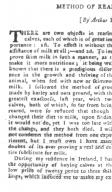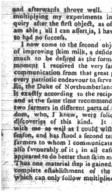[ Method of Rearing Young Cattle ] Arthur Young
Date: 1790/11/03
Source:
Nova Scotia Magazine
Institution: Nova Scotia Archives
| Source Origin: Nova Scotia Newspapers on Microfilm
| Reference: Microfilm Reels 8062, 8063
Report on several failed experiments in feeding calves, followed by a recipe for milk that was successfully used. nn.363_64. Microfilm Reel 8063.
METHOD OF REARING YOUNG CATTLE.
[By Arthur Young, Esq; F. R. S.]
THERE are two objects in rearing
calves, each of which is of great im-
portance: 1st. To effect it without the
assistance of milk at all;--and 2d. To im-
prove skim milk in such a manner, as to
make it more nutritious; it being well
known that there is a prodigious differ-
ence in the growth and thriving of the
animal, when fed with new or skimmed
milk. I followed the method of gruel
made by barley and oats ground, with the
greatest exactness, last year, with two
calves, both of which, so far from being
reared, were so reduced that though I
changed their diet to milk, upon finding
it would not do, yet I was too late with
the change, and they both died. I will
not condemn the method from one expe-
riment, but i must own I have many
doubts of its ever proving a real and en-
tire substitute for milk.
During my residence in Ireland, I had
the opportunity of buying calves at the
low price of twenty pence to three shil-
lings, which induced me to make my ex-
___
periments on this enquiry. Knowing;
before I went, the cheapness of calves, I
had collected various receipts for weaning
them; among others, hay tea, bean meal
mixed with wheat, flour, barley, and oats,
ground, nearly, but not exactly in Mr.
Budd’s proportion; but principally flax-
seed boiled to a jelly, and mixed with
warm water. This being recommended
more than the rest, I tried it on more
calves. The general result I well remem-
ber. Of above thirty calves, I reared not
more than three of four: and I was con-
vinced, as strongly as the experiments of
one season could convince me, that none
of the methods tried, deserved reliance.
Barley and oatmeal, with a little flax jel-
ly, reared the few that escaped, except
one, on which a trial was made at the
suggestion of my coachman, who had rear-
ed many calves. He desired to mix two-
thirds skim milk and one third water, with
a small addition of flax-seed jelly, dissol-
ved. That calf recovered quickly from
the low condition it had been reduced to,
and afterwards throve well. I intend
multiplying my experiments in the en-
quiry after the first object, as often as I
am able; all I can assert is, I have hither-
to had no success.
I now come to the second object, that
of improving skim milk, a desideratum as
much to be desired as the former. The
moment I received the very satisfactory
communication from that great patron of
every patriotic endeavour to serve the pub-
lic, the Duke of Northumberland, I tried
it exactly according to the recipe below,
and at the same time recommended it to
two farmers in different parts of the king-
dom, who, I knew, were solicitous for
discoveries of this kind. It answered
with me as well as I could with the first
season, and has stood a second test. The
farmers to whom I communicated, report
also favourably of it; in all cases it has
appeared to do better than skim milk alone.
Thus one material step is gained, not the
complete establishment of the method,
which can only follow multiplied and va-
___
ried experiments, but a proof that it may
be very safely recommended, to those who
are the most cautious, and the most fear-
ful of incurring expence.
RECIPE
Take one gallon of skimmed milk, and
in about a pint of it add half an ounce of
common treacle (melasses) stirring it un-
til it is well mixed. Then take one ounce
of linseed oil cake well powdered, and with
the hand let it fall gradually, in very small
quantities, into the milk, stirring it in the
mean time with a spoon or ladle, until it
be thoroughly incorporated. Then let the
mixture be put into the other part of the
milk, and the whole be made as nearly
warm as new milk, when it is first taken
from the cow, and in that state it is fit for
use.
N.B. The quantity of the oil cake
powdered, may, from time to time, be in-
creased as occasion may require, and as
the calf becomes inured to the flavour of
it.
Download: Transcription | Images

